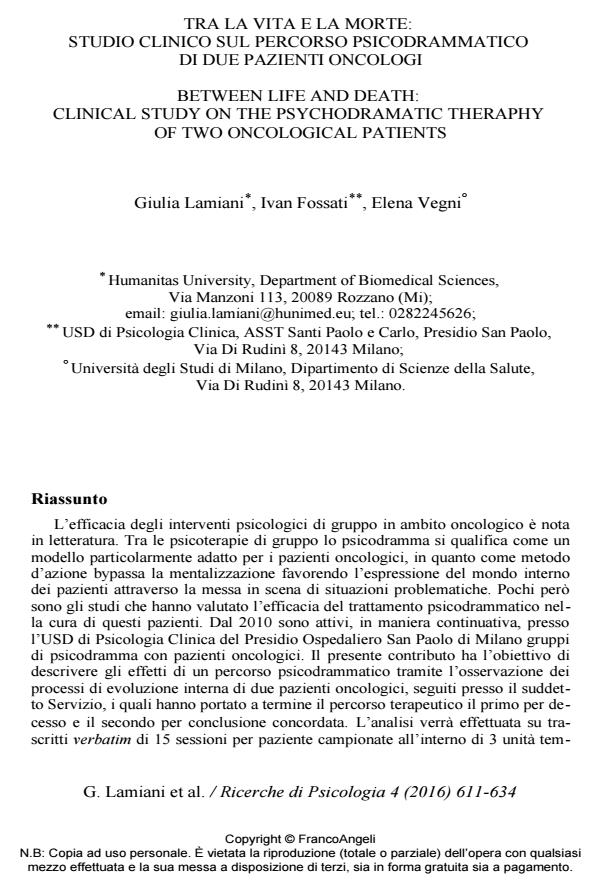Between life and death: clinical study on the psychodramatic theraphy of two oncological patients
Journal title RICERCHE DI PSICOLOGIA
Author/s Giulia Lamiani, Ivan Fossati, Elena Vegni
Publishing Year 2017 Issue 2016/4
Language Italian Pages 24 P. 611-634 File size 259 KB
DOI 10.3280/RIP2016-004008
DOI is like a bar code for intellectual property: to have more infomation
click here
Below, you can see the article first page
If you want to buy this article in PDF format, you can do it, following the instructions to buy download credits

FrancoAngeli is member of Publishers International Linking Association, Inc (PILA), a not-for-profit association which run the CrossRef service enabling links to and from online scholarly content.
The efficacy of psychological group interventions for cancer patients is known in the literature. Among group psychotherapies, psychodrama is a model which is particularly suitable for cancer patients. As an action method, psychodrama overcomes mentalization and promotes the expression of the internal world through the enactment of problematic situations. However, only a few studies have assessed the efficacy of psychodrama groups with cancer patients. From 2010, two psychodrama therapy groups for cancer patients have been offered on a regular basis at San Paolo Hospital, Milan. This study aims to describe the effects of psychodrama therapy through the description of the internal processes of two patients who ended the therapy in one case due to death and in the second case for shared decision. The verbatim transcripts of 15 sessions per patient were analyzed, corresponding the initial, middle and final phase of therapy. The analysis of the transcript according to the Interpretative Phenomenological Approach, allowed us to highlight the evolution and psychological growth of these two patients.
Keywords: Psychodrama, group therapy, cancer, psychotherapy effectiveness
- The effect of drama on psychosocial problems and emotional states of hospitalized children with cancer Fatma Betül Şenol, Yiğit Şenol, in Journal of Pediatric Nursing /2024 pp.e276
DOI: 10.1016/j.pedn.2024.04.041 - Surveying 80 Years of Psychodrama Research: A Scientometric Review Mengyu Lim, Alessandro Carollo, S. H. Annabel Chen, Gianluca Esposito, in Frontiers in Psychiatry 780542/2021
DOI: 10.3389/fpsyt.2021.780542
Giulia Lamiani, Ivan Fossati, Elena Vegni, Tra la vita e la morte: studio clinico sul percorso psicodrammatico di due pazienti oncologi in "RICERCHE DI PSICOLOGIA " 4/2016, pp 611-634, DOI: 10.3280/RIP2016-004008